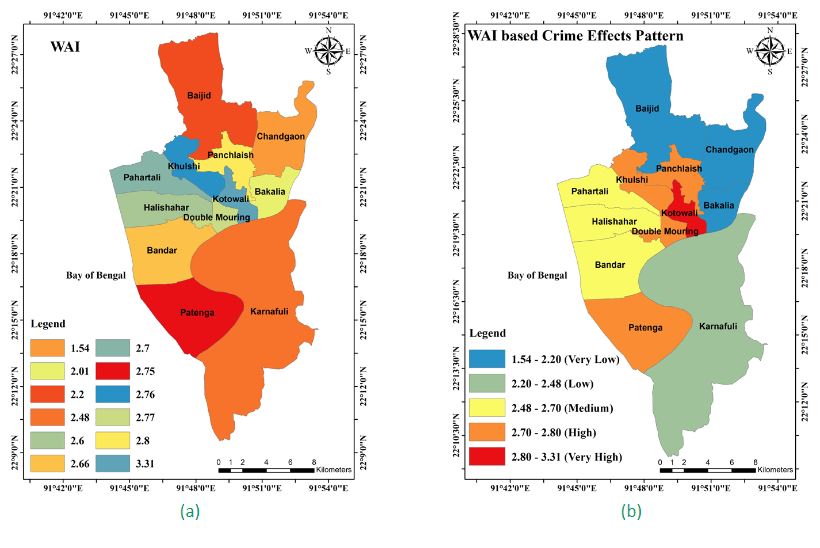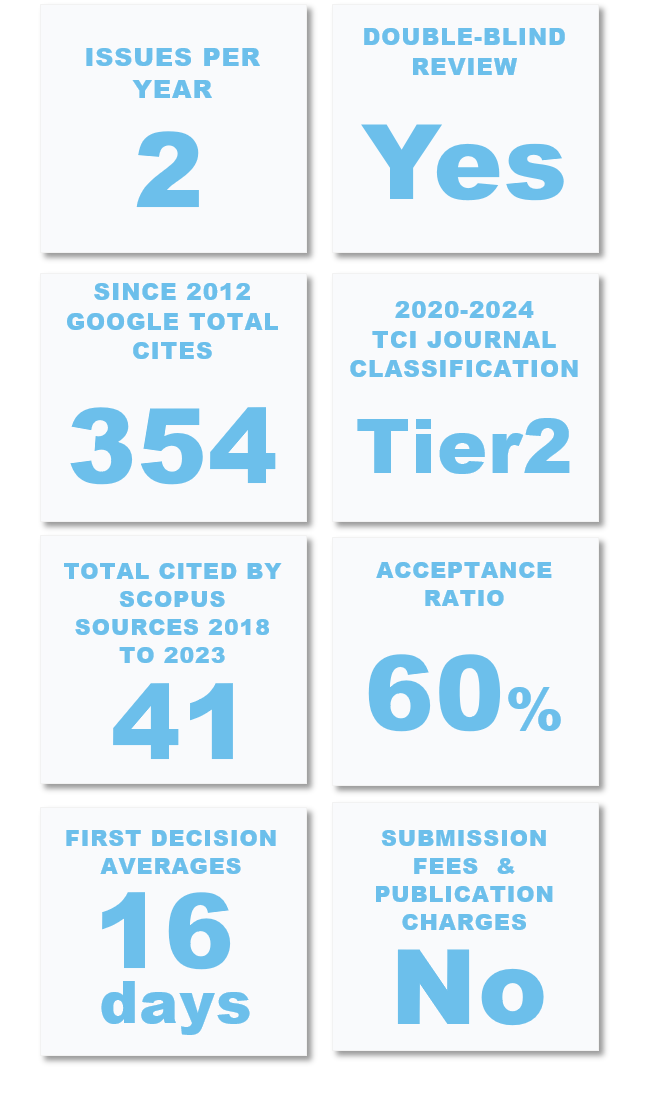Spatial Perception Analysis of the Socio-Economic Effect of Urban Street Crime in the Residential Neighborhoods in Chittagong City, Bangladesh
Keywords:
Chittagong City, effects of crime, residential neighborhood, spatial perception analysis, victim of street crimeAbstract
Urban street crime (USC) has an immense effect on the residential neighborhoods (RN) and other sectors of urban life with a variation in the intra-city or intercity. The study explored the spatial perception variation of the socio-economic effects of USC in the RN in Chittagong City (CC), Bangladesh. Household-level questionnaire surveys, key informants interview, group discussion, and in-depth interviews were conducted for primary data collection. Besides, a GPS instrument was used for spatial data collection. Primary data were compared with official crime statistics. Literature was reviewed for the formulation of street crime and methodology development. Qualitative and quantitative techniques and SPSS software were used in data analysis. The study revealed that types of USC are huge, however, city dwellers frequently victims due to snatching, theft, political violence, and eve-teasing. The target of USC is higher in male people compare to women. The vital effect of USC in the RN is psychological, it creates mental panic, and therefore, people scared to move and young adult women hesitate to go outside their home to perform daily activities. In conclusion, further investigation is needed to determine the other causes and effects and solutions of USC for safe and sustainable city life.
Downloads
References
Bangladesh Police (2018). Crime Statistics, Retrieved from https://www.police.gov.bd/en/crime_statistic/year/2018, Accessed on 27 May 2019
Bhattacherjee, A. (2012). Social Science Research: Principles, Methods, and Practices. University of South Florida: Florida.
BRAC Institute of Governance and Development (BIGD). (2014). State of Cities: Governance for a Liveable Chittagong. BRAC Institute of Governance and Development, BRAC University, Dhaka.
Brown, S. E., Esbensen, F. A. & Geis, G. (2012). Criminology: Explaining crime and its context. Routledge.
Chatogram Metropolitan Police (2013). Information of Police Station, Retrieved from http://www.cmp.gov.bd/index.php?cPath=295, Accessed on 15 January 2018.
Chowdhury, U. (2011). Spatial Distribution of Street Crime Occurrences in Dhaka City, The AUST Journal of Science and Technology, Vol.3. 2(July 2011), 1-11.
Glaeser, E. L. & Sacerdote, B. (1999).Why is there more crime in cities? Journal of political economy, 107(S6), S225-S258.
Guthrie, G. (2010). Basic research methods: An entry to social science research. SAGE Publications India.
Haider, M. A., & Iamtrakul, P. (2018). Theoretical Concepts of Crime and Practices in Urban Planning and Design Process for Safe Urban Life. International Journal of Building, Urban, Interior, and Landscape Technology (BUILT), 12, 7-24. Retrieved from https://ph02.tci-thaijo.org/index.php/BUILT/article/view/169199
Haider, M.A. (2015). Crime Analysis in Chittagong City: An Inquiry into the Socio-Economic and Spatial Factors, Master Thesis, Asian Institute of Technology (AIT), Thailand.
Hannis, C. K. (2015). Understanding the Victim-Offender Overlap: An Exploratory Study.
Islam, M.S, & Khan, N.U., (2012). Urban Spatial Growth: The Case of Bangladesh, Retrieved from https://www.mshahidulislam.com/pdfdoc2/Urbanization_Book%20Chapter_Urban%20Spatial%20Growth_shahid_nasir_02%20dec%202012.pdf, Accessed on 7 June 2019
Kitchen, P. F. (2006). Exploring the link between crime and socio-economic status in Ottawa and Saskatoon: A small-area geographical analysis. Department of Justice, Research, and Statistics Division.
Lindgren, M. & Nikolic-Ristanovic, V. (2011). Crime victims: International and Serbian perspective. Organization for Security and Cooperation in Europe, Mission to Serbia, Law Enforcement Department.
MacDonald, J., Bluthenthan, R. N., Golinelli, D., Kofner, A. & Stokes, R. J. (2009). Neighborhood effects on crime and youth violence: the role of business improvement districts in Los Angeles (Vol. 622). Rand Corporation.
Miah, A. Q. (2016). Applied statistics for social and management sciences. Singapore: Springer.
Nath, B., Niu, Z. & Singh, R.P. (2018). Land Use and Land Cover Changes, and Environment and Risk Evaluation of Dujiangyan City (SW China) Using Remote Sensing and GIS Techniques, Sustainability, 10, 4631. Retrieved from https://doi.org/10.3390/su10124631.
Nath, B., Wang, Z., Ge, Y., Islam, K., Singh, R.P. & Niu, Z. (2020). Land Use and Land Cover Change Modeling and Future Potential Landscape Risk Assessment Using Markov-CA Model and Analytical Hierarchy Process, ISPRS International Journal of Geo-Information, 9(2), 134. Retrieved fromhttps://doi.org/10.3390/ijgi9020134.
Rahman, M.M. (2013). Urbanization and Urban crime in Bangladesh, Retrieved fromhttp://www.police.gov.bd/userfiles/file/UrbanizationAndUrbaCrimeInBangladesh.pdf.
Reid, S., Tita, G. & Valasik, M. (2011). The Mapping and Spatial Analysis of Crime. Oxford University Press.
Salehi, E. (2010). Environmental factors and urban crime. In 22nd International Housing Research Conference.
Samad, M. R. B., Chisty, K. U., & Rahman, A. (2016). Urbanization and Urban Growth Dynamics: A Study on Chittagong City. Journal of Bangladesh Institute of Planners. Journal of Bangladesh Institute of Planners Vol. 8, 2015 (Printed in December 2016), 167-174,
Santana, P., Santos, R., Costa, C., Roque, N. & Loureiro, A. (2009). Crime and the urban environment: Impact on human health. In City Futures in a Globalizing World. An international conference on globalism and urban change (Vol. 4).
Soomeren, P. V. (2013). A set of European CPTED Standards for Secure Cities- Safe and Secure cities through Urban Design, and Planning: standardizing the process, European Designing Out Crime Association, Amsterdam, The Netherlands.
Spence, M., Annez, P. C. & Buckley, R. M. (Eds.).(2008). Urbanization and growth. World Bank Publications.
Taylor, R. B., & Harrell, A. (1996). Physical environment and crime Washington, DC: US Department of Justice, Office of Justice Programs, National Institute of Justice.
The Chittagong Metropolitan Police Ordinance. (1978). Ministry of Law, Government of Bangladesh. Archived from the original (PDF) on 4 March 2016. Retrieved from https://web.archive.org/web/20160304022639/ http://bdlaws.minlaw.gov.bd/pdf/578__II_.pdf. Accessed on 19 June 2020.
Uddin, N. (2018). Assessing urban sustainability of slum settlements in Bangladesh: Evidence from Chittagong city. Journal of Urban Management, 7(1), pp. 32-42.
Ulmer, J. T., & Steffensmeier, D. J. (2014). The age and crime relationship: Social variation, social explanations. The nurture versus biosocial debate in criminology: On the origins of criminal behavior and criminality (pp. 377-396). SAGE Publications Inc.
United Nations (UN), (2015).Transforming our world: The 2030 Agenda for Sustainable Development. Resolution Adopted by the General Assembly on 25 September 2015, Retrieved from http://www.un.org/ga/search/viewdoc.asp?Symbol=A/RES/70/1&Lang=E, Accessed on 20 January 2020 at 11 AM
United Nations Office on Drugs and Crime (UNODC) and the World Bank (2007). Crime, Violence, and Development: Trends, Costs, and Policy Options in the Caribbean, Report No. 37820.
the United Nations Office on Drugs and Crime and the Latin America and the Caribbean Region of the World Bank. (2007). Crime, Violence, and Development: Trends, Costs, and Policy Options in the Caribbean. Retrieved from https://www.unodc.org/pdf/research/Cr_and_Vio_Car_E.pdf
Vogel, M., & South, S. J. (2016). Spatial dimensions of the effect of neighborhood disadvantage on delinquency. Criminology, 54(3), pp.434-458.
Wasserman, E., & Ellis, C. A. (2010). Impact of Crime on Victims. National Victim Assistance Academy, Track 1, Foundation-Level Training.
Weather and Climate (2019). Climate in Chittagong, Bangladesh, Retrieved from https://weather-and-climate.com/average-monthly-Rainfall-Temperature-Sunshine,Chittagong,Bangladesh, Accessed on 19 June 2020.
Yazdanfar, S. A. A. & Nazari, N. (2015).Proposed physical- environmental factors influencing personal and social security in residential areas. Procedia-Social and Behavioral Sciences, 201, pp.224-233.
Zhang, H. & Peterson, M.P. (2007). A spatial analysis of neighborhood crime in Omaha, Nebraska using alternative measures of crime rates.

Downloads
Published
How to Cite
Issue
Section
License
Copyright (c) 2020 International Journal of Building, Urban, Interior and Landscape Technology (BUILT)

This work is licensed under a Creative Commons Attribution-NonCommercial-NoDerivatives 4.0 International License.











